Control A Citroen C4 PICASSO 2009 1.G Manual Online
[x] Cancel search | Manufacturer: CITROEN, Model Year: 2009, Model line: C4 PICASSO, Model: Citroen C4 PICASSO 2009 1.GPages: 337, PDF Size: 12.91 MB
Page 147 of 337
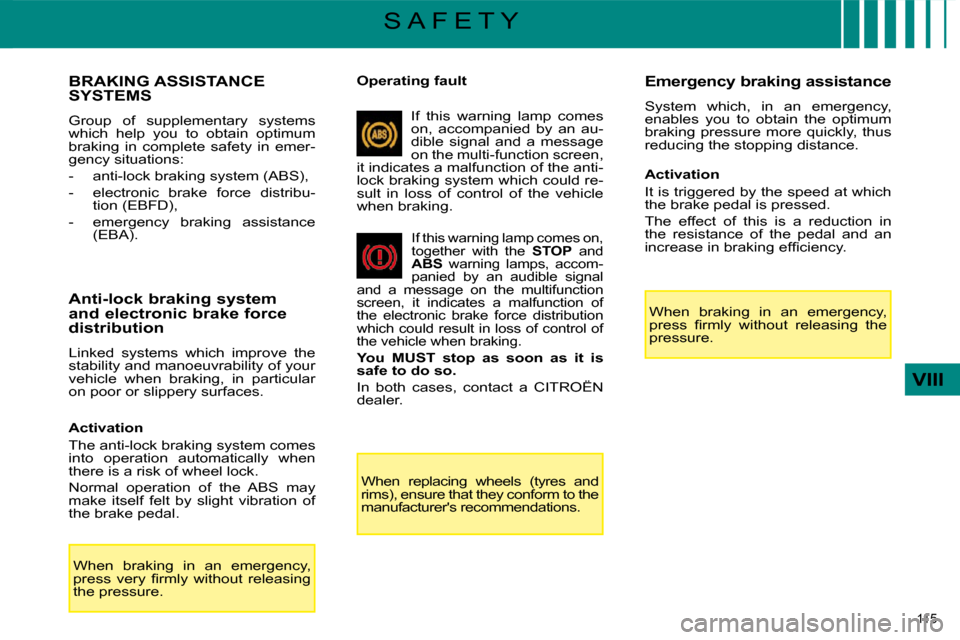
115
VIII
S A F E T Y
BRAKING ASSISTANCE SYSTEMS
Group of supplementary systems
which help you to obtain optimum
braking in complete safety in emer-
gency situations:
- anti-lock braking system (ABS),
- electronic brake force distribu-tion (EBFD),
- emergency braking assistance (EBA).
Anti-lock braking system
and electronic brake force
distribution
Linked systems which improve the
stability and manoeuvrability of your
vehicle when braking, in particular
on poor or slippery surfaces.
Activation
The anti-lock braking system comes
into operation automatically when
there is a risk of wheel lock.
Normal operation of the ABS may
make itself felt by slight vibration of
the brake pedal. Operating fault
When braking in an emergency,
�p�r�e�s�s� �v�e�r�y� �fi� �r�m�l�y� �w�i�t�h�o�u�t� �r�e�l�e�a�s�i�n�g�
the pressure. If this warning lamp comes
on, accompanied by an au-
dible signal and a message
on the multi-function screen,
it indicates a malfunction of the anti-
lock braking system which could re-
sult in loss of control of the vehicle
when braking.
If this warning lamp comes on,
together with the STOP and
ABS warning lamps, accom-
panied by an audible signal
and a message on the multifunction
screen, it indicates a malfunction of
the electronic brake force distribution
which could result in loss of control of
the vehicle when braking.
You MUST stop as soon as it is
safe to do so.
In both cases, contact a CITROËN
dealer.
When replacing wheels (tyres and
rims), ensure that they conform to the
manufacturer's recommendations. Emergency braking assistance
System which, in an emergency, enables you to obtain the optimum braking pressure more quickly, thus reducing the stopping distance.
Activation
It is triggered by the speed at which the brake pedal is pressed.
The effect of this is a reduction in the resistance of the pedal and an �i�n�c�r�e�a�s�e� �i�n� �b�r�a�k�i�n�g� �e�f�fi� �c�i�e�n�c�y�.�
When braking in an emergency, �p�r�e�s�s� �fi� �r�m�l�y� �w�i�t�h�o�u�t� �r�e�l�e�a�s�i�n�g� �t�h�e� pressure.
Page 148 of 337
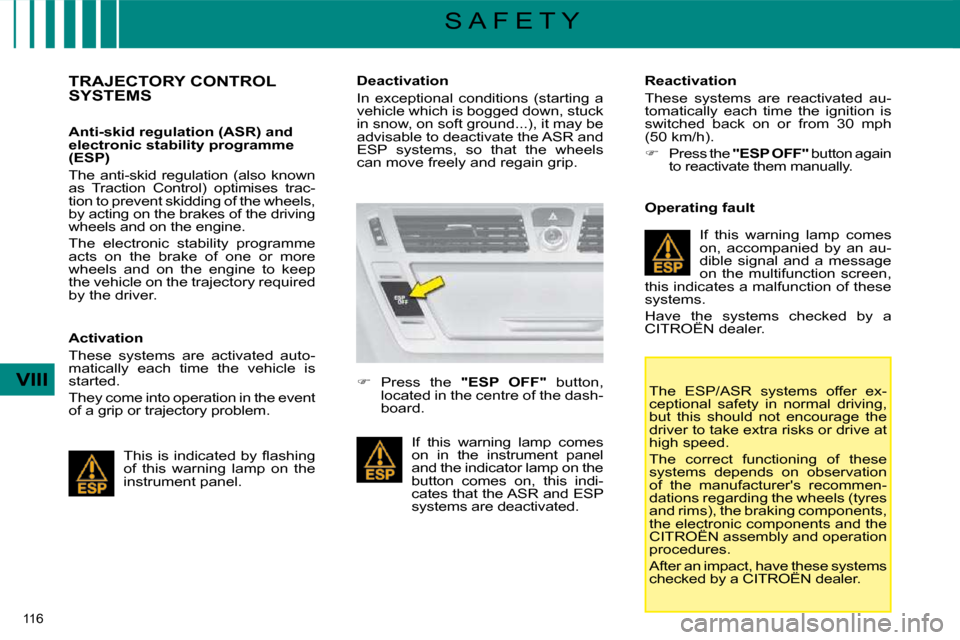
116
VIII
S A F E T Y
TRAJECTORY CONTROL SYSTEMS
Anti-skid regulation (ASR) and
electronic stability programme
(ESP)
The anti-skid regulation (also known
as Traction Control) optimises trac-
tion to prevent skidding of the wheels,
by acting on the brakes of the driving
wheels and on the engine.
The electronic stability programme
acts on the brake of one or more
wheels and on the engine to keep
the vehicle on the trajectory required
by the driver.
Activation
These systems are activated auto-
matically each time the vehicle is
started.
They come into operation in the event
of a grip or trajectory problem. � �T�h�i�s� �i�s� �i�n�d�i�c�a�t�e�d� �b�y� �fl� �a�s�h�i�n�g�
of this warning lamp on the
instrument panel. Deactivation
� �I�n� �e�x�c�e�p�t�i�o�n�a�l� �c�o�n�d�i�t�i�o�n�s� �(�s�t�a�r�t�i�n�g� �a�
vehicle which is bogged down, stuck
in snow, on soft ground...), it may be
advisable to deactivate the ASR and
ESP systems, so that the wheels
can move freely and regain grip.
� Press the "ESP OFF" button,
located in the centre of the dash-
board. Reactivation
These systems are reactivated au-
tomatically each time the ignition is
switched back on or from 30 mph
(50 km/h).
� Press the "ESP OFF" button again
to reactivate them manually.
If this warning lamp comes
on in the instrument panel
and the indicator lamp on the
button comes on, this indi-
cates that the ASR and ESP
systems are deactivated. Operating fault
If this warning lamp comes
on, accompanied by an au-
dible signal and a message
on the multifunction screen,
this indicates a malfunction of these
systems.
Have the systems checked by a
CITROËN dealer.
� �T�h�e� �E�S�P�/�A�S�R� �s�y�s�t�e�m�s� �o�f�f�e�r� �e�x�-
ceptional safety in normal driving,
but this should not encourage the
�d�r�i�v�e�r� �t�o� �t�a�k�e� �e�x�t�r�a� �r�i�s�k�s� �o�r� �d�r�i�v�e� �a�t�
high speed.
The correct functioning of these
systems depends on observation
of the manufacturer's recommen-
dations regarding the wheels (tyres
and rims), the braking components,
the electronic components and the
CITROËN assembly and operation
procedures.
After an impact, have these systems
checked by a CITROËN dealer.
Page 158 of 337
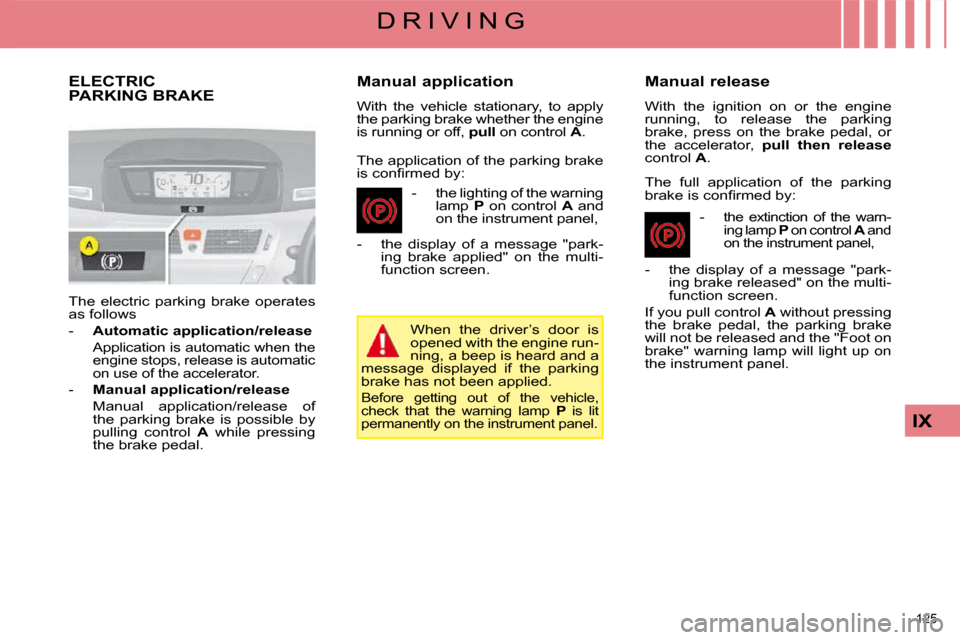
125
IX
D R I V I N G
ELECTRIC PARKING BRAKE
The electric parking brake operates
as follows
- Automatic application/release
Application is automatic when the
engine stops, release is automatic
on use of the accelerator.
- Manual application/release
Manual application/release of the parking brake is possible by
pulling control A while pressing
the brake pedal. Manual application
With the vehicle stationary, to apply
the parking brake whether the engine
is running or off,
pull on control A . Manual release
With the ignition on or the engine
running, to release the parking
brake, press on the brake pedal, or
the accelerator,
pull then release
control A .
-
the extinction of the warn- ing lamp P on control A and
on the instrument panel,
- the display of a message "park- ing brake released" on the multi-
function screen.
If you pull control A without pressing
the brake pedal, the parking brake
will not be released and the "Foot on
brake" warning lamp will light up on
the instrument panel.
The application of the parking brake
�i�s� �c�o�n�fi� �r�m�e�d� �b�y�:�
- the lighting of the warning lamp P on control A and
on the instrument panel,
- the display of a message "park- ing brake applied" on the multi-
function screen.
When the driver’s door is
opened with the engine run-
ning, a beep is heard and a
message displayed if the parking
brake has not been applied.
Before getting out of the vehicle,
check that the warning lamp P is lit
permanently on the instrument panel.
The full application of the parking
�b�r�a�k�e� �i�s� �c�o�n�fi� �r�m�e�d� �b�y�:�
Page 159 of 337
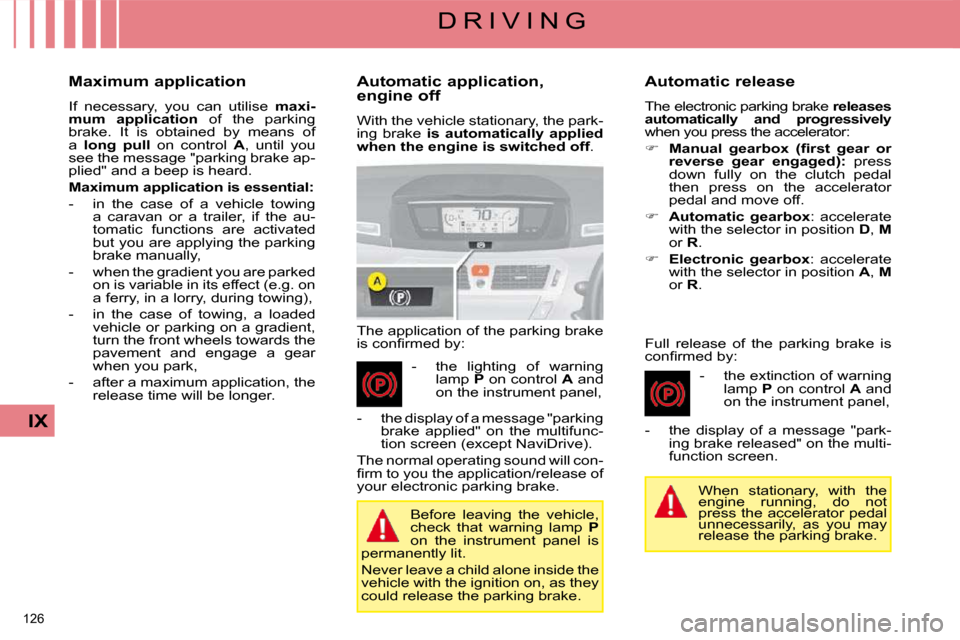
126
IX
D R I V I N G
Automatic application,
engine off
With the vehicle stationary, the park-
ing brake is automatically applied
when the engine is switched off .
The application of the parking brake
�i�s� �c�o�n�fi� �r�m�e�d� �b�y�:� - the lighting of warning lamp P on control A and
on the instrument panel, Automatic release
The electronic parking brake
releases
automatically and progressively
� �w�h�e�n� �y�o�u� �p�r�e�s�s� �t�h�e� �a�c�c�e�l�e�r�a�t�o�r�:�
� Manual gearbox �(�fi� �r�s�t� �g�e�a�r� �o�r�
reverse gear engaged): press
down fully on the clutch pedal
then press on the accelerator
pedal and move off.
� Automatic gearbox � �:� �a�c�c�e�l�e�r�a�t�e�
with the selector in position D , M
or R .
� Electronic gearbox � �:� �a�c�c�e�l�e�r�a�t�e�
with the selector in position A , M
or R .
Full release of the parking brake is
�c�o�n�fi� �r�m�e�d� �b�y�:� - the extinction of warning lamp P on control A and
on the instrument panel,
- the display of a message "park- ing brake released" on the multi-
function screen.
When stationary, with the
engine running, do not
press the accelerator pedal
unnecessarily, as you may
release the parking brake.
Maximum application
If necessary, you can utilise
maxi-
mum application of the parking
brake. It is obtained by means of
a long pull on control A , until you
see the message "parking brake ap-
plied" and a beep is heard.
Maximum application is essential:
- in the case of a vehicle towing a caravan or a trailer, if the au-
tomatic functions are activated
but you are applying the parking
brake manually,
- when the gradient you are parked on is variable in its effect (e.g. on
a ferry, in a lorry, during towing),
- in the case of towing, a loaded vehicle or parking on a gradient,
turn the front wheels towards the
pavement and engage a gear
when you park,
- after a maximum application, the release time will be longer.
Before leaving the vehicle,
check that warning lamp P
on the instrument panel is
permanently lit.
Never leave a child alone inside the
vehicle with the ignition on, as they
could release the parking brake.
- the display of a message "parking
brake applied" on the multifunc-
tion screen (except NaviDrive).
The normal operating sound will con-
�fi� �r�m� �t�o� �y�o�u� �t�h�e� �a�p�p�l�i�c�a�t�i�o�n�/�r�e�l�e�a�s�e� �o�f�
your electronic parking brake.
Page 160 of 337
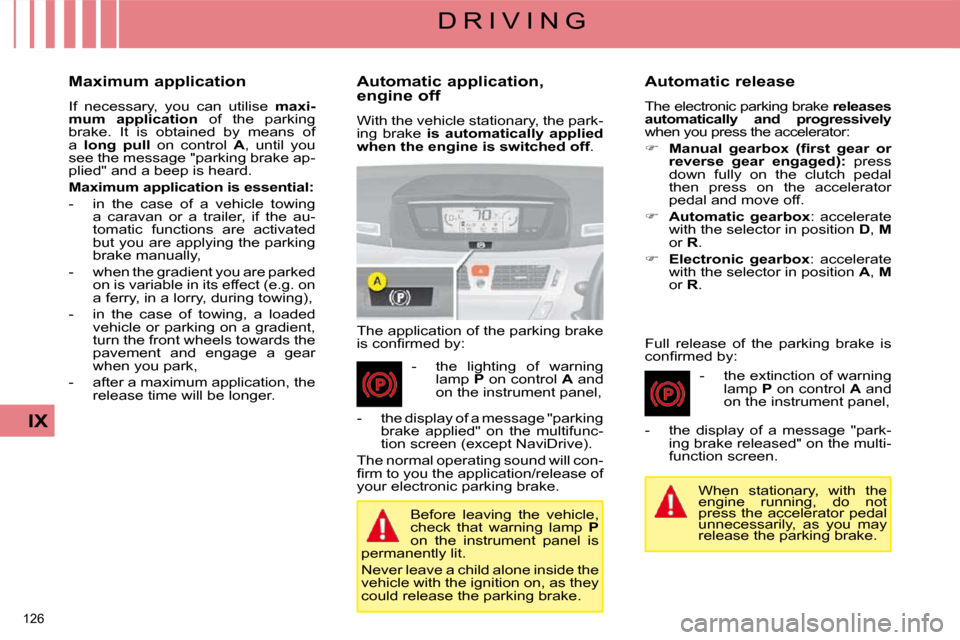
126
IX
D R I V I N G
Automatic application,
engine off
With the vehicle stationary, the park-
ing brake is automatically applied
when the engine is switched off .
The application of the parking brake
�i�s� �c�o�n�fi� �r�m�e�d� �b�y�:� - the lighting of warning lamp P on control A and
on the instrument panel, Automatic release
The electronic parking brake
releases
automatically and progressively
� �w�h�e�n� �y�o�u� �p�r�e�s�s� �t�h�e� �a�c�c�e�l�e�r�a�t�o�r�:�
� Manual gearbox �(�fi� �r�s�t� �g�e�a�r� �o�r�
reverse gear engaged): press
down fully on the clutch pedal
then press on the accelerator
pedal and move off.
� Automatic gearbox � �:� �a�c�c�e�l�e�r�a�t�e�
with the selector in position D , M
or R .
� Electronic gearbox � �:� �a�c�c�e�l�e�r�a�t�e�
with the selector in position A , M
or R .
Full release of the parking brake is
�c�o�n�fi� �r�m�e�d� �b�y�:� - the extinction of warning lamp P on control A and
on the instrument panel,
- the display of a message "park- ing brake released" on the multi-
function screen.
When stationary, with the
engine running, do not
press the accelerator pedal
unnecessarily, as you may
release the parking brake.
Maximum application
If necessary, you can utilise
maxi-
mum application of the parking
brake. It is obtained by means of
a long pull on control A , until you
see the message "parking brake ap-
plied" and a beep is heard.
Maximum application is essential:
- in the case of a vehicle towing a caravan or a trailer, if the au-
tomatic functions are activated
but you are applying the parking
brake manually,
- when the gradient you are parked on is variable in its effect (e.g. on
a ferry, in a lorry, during towing),
- in the case of towing, a loaded vehicle or parking on a gradient,
turn the front wheels towards the
pavement and engage a gear
when you park,
- after a maximum application, the release time will be longer.
Before leaving the vehicle,
check that warning lamp P
on the instrument panel is
permanently lit.
Never leave a child alone inside the
vehicle with the ignition on, as they
could release the parking brake.
- the display of a message "parking
brake applied" on the multifunc-
tion screen (except NaviDrive).
The normal operating sound will con-
�fi� �r�m� �t�o� �y�o�u� �t�h�e� �a�p�p�l�i�c�a�t�i�o�n�/�r�e�l�e�a�s�e� �o�f�
your electronic parking brake.
Page 161 of 337
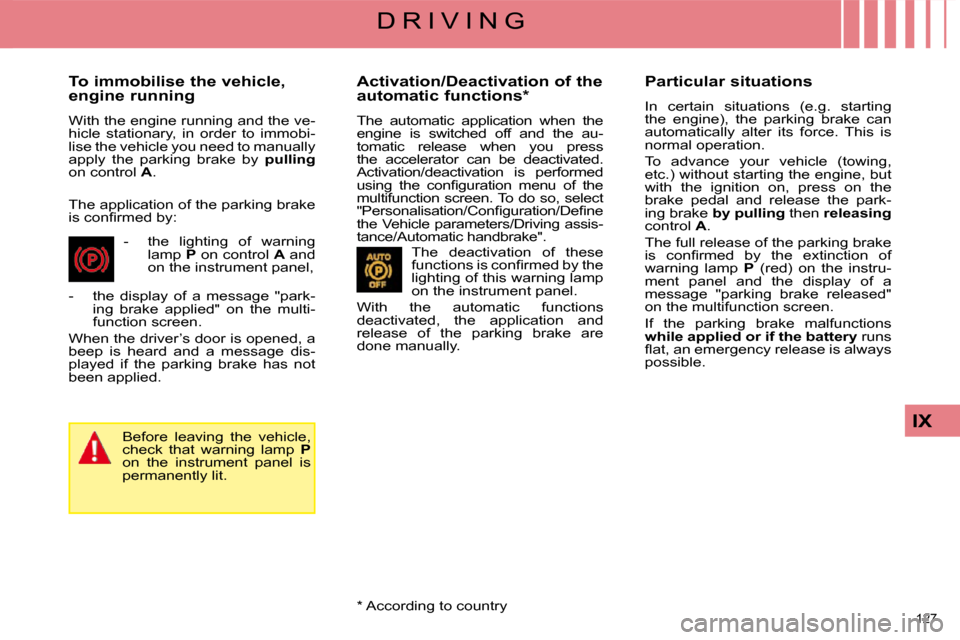
127
IX
D R I V I N G
To immobilise the vehicle,
engine running
With the engine running and the ve-
hicle stationary, in order to immobi-
lise the vehicle you need to manually
apply the parking brake by pulling
on control A .
The application of the parking brake
�i�s� �c�o�n�fi� �r�m�e�d� �b�y�:� - the lighting of warning lamp P on control A and
on the instrument panel,
- the display of a message "park- ing brake applied" on the multi-
function screen.
When the driver’s door is opened, a
beep is heard and a message dis-
played if the parking brake has not
been applied.
Before leaving the vehicle,
check that warning lamp P
on the instrument panel is
permanently lit. Particular situations
In certain situations (e.g. starting
the engine), the parking brake can
automatically alter its force. This is
normal operation.
To advance your vehicle (towing,
etc.) without starting the engine, but
with the ignition on, press on the
brake pedal and release the park-
ing brake
by pulling then releasing
control A .
The full release of the parking brake
�i�s� �c�o�n�fi� �r�m�e�d� �b�y� �t�h�e� �e�x�t�i�n�c�t�i�o�n� �o�f�
warning lamp P (red) on the instru-
ment panel and the display of a
message "parking brake released"
on the multifunction screen.
If the parking brake malfunctions
while applied or if the battery runs
�fl� �a�t�,� �a�n� �e�m�e�r�g�e�n�c�y� �r�e�l�e�a�s�e� �i�s� �a�l�w�a�y�s�
possible.
Activation/Deactivation of the
automatic functions *
The automatic application when the
engine is switched off and the au-
tomatic release when you press
the accelerator can be deactivated.
Activation/deactivation is performed
�u�s�i�n�g� �t�h�e� �c�o�n�fi� �g�u�r�a�t�i�o�n� �m�e�n�u� �o�f� �t�h�e�
multifunction screen. To do so, select
�"�P�e�r�s�o�n�a�l�i�s�a�t�i�o�n�/�C�o�n�fi� �g�u�r�a�t�i�o�n�/�D�e�fi� �n�e�
the Vehicle parameters/Driving assis-
tance/Automatic handbrake".
The deactivation of these
�f�u�n�c�t�i�o�n�s� �i�s� �c�o�n�fi� �r�m�e�d� �b�y� �t�h�e�
lighting of this warning lamp
on the instrument panel.
With the automatic functions
deactivated, the application and
release of the parking brake are
done manually.
* According to country
Page 162 of 337
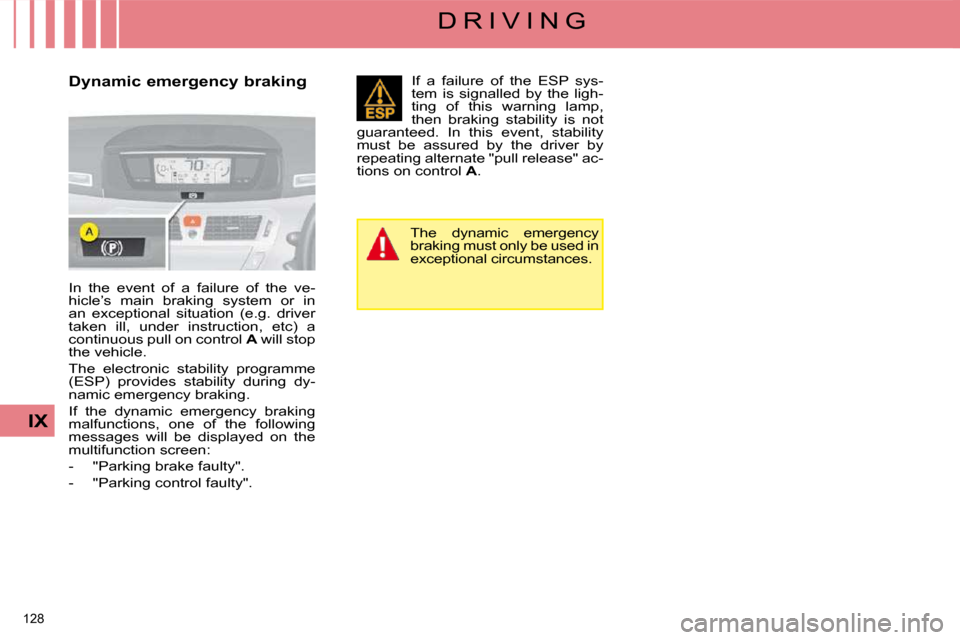
128
IX
D R I V I N G
Dynamic emergency braking
In the event of a failure of the ve-
hicle’s main braking system or in
an exceptional situation (e.g. driver
taken ill, under instruction, etc) a
continuous pull on control A will stop
the vehicle.
The electronic stability programme
(ESP) provides stability during dy-
namic emergency braking.
If the dynamic emergency braking
malfunctions, one of the following
messages will be displayed on the
�m�u�l�t�i�f�u�n�c�t�i�o�n� �s�c�r�e�e�n�:�
- "Parking brake faulty".
- "Parking control faulty". If a failure of the ESP sys-
tem is signalled by the ligh-
ting of this warning lamp,
then braking stability is not
guaranteed. In this event, stability
must be assured by the driver by
repeating alternate "pull release" ac-
tions on control A .
The dynamic emergency
braking must only be used in
exceptional circumstances.
Page 163 of 337
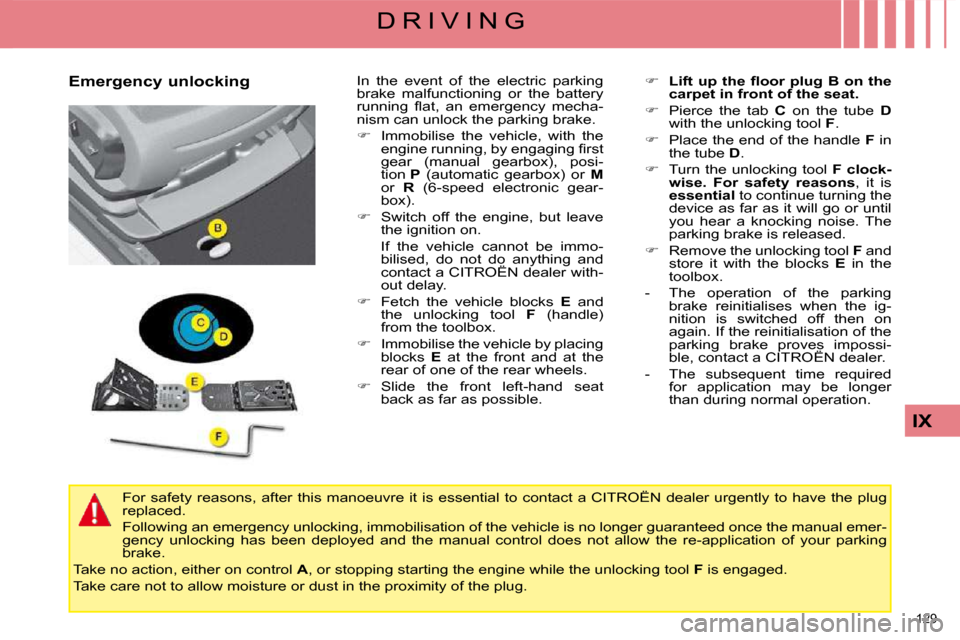
129
IX
D R I V I N G
Emergency unlocking In the event of the electric parking
brake malfunctioning or the battery
�r�u�n�n�i�n�g� �fl� �a�t�,� �a�n� �e�m�e�r�g�e�n�c�y� �m�e�c�h�a�-
nism can unlock the parking brake.
� Immobilise the vehicle, with the
�e�n�g�i�n�e� �r�u�n�n�i�n�g�,� �b�y� �e�n�g�a�g�i�n�g� �fi� �r�s�t�
gear (manual gearbox), posi-
tion P (automatic gearbox) or M
or R (6-speed electronic gear-
box).
� Switch off the engine, but leave
the ignition on.
If the vehicle cannot be immo- bilised, do not do anything and
contact a CITROËN dealer with-
out delay.
� Fetch the vehicle blocks E and
the unlocking tool F (handle)
from the toolbox.
� Immobilise the vehicle by placing
blocks E at the front and at the
rear of one of the rear wheels.
� Slide the front left-hand seat
back as far as possible.
� �L�i�f�t� �u�p� �t�h�e� �fl� �o�o�r� �p�l�u�g B
on the
carpet in front of the seat.
� Pierce the tab C on the tube D
with the unlocking tool F .
� Place the end of the handle F in
the tube D .
� Turn the unlocking tool F clock-
wise.
For safety reasons , it is
essential to continue turning the
device as far as it will go or until
you hear a knocking noise. The
parking brake is released.
� Remove the unlocking tool F and
store it with the blocks E in the
toolbox.
- The operation of the parking brake reinitialises when the ig-
nition is switched off then on
again. If the reinitialisation of the
parking brake proves impossi-
ble, contact a CITROËN dealer.
- The subsequent time required for application may be longer
than during normal operation.
For safety reasons, after this manoeuvre it is essential to cont act a CITROËN dealer urgently to have the plug
replaced.
Following an emergency unlocking, immobilisation of the vehi cle is no longer guaranteed once the manual emer-
gency unlocking has been deployed and the manual control doe s not allow the re-application of your parking
brake.
Take no action, either on control A , or stopping starting the engine while the unlocking to ol F is engaged.
Take care not to allow moisture or dust in the proximity of th e plug.
Page 165 of 337
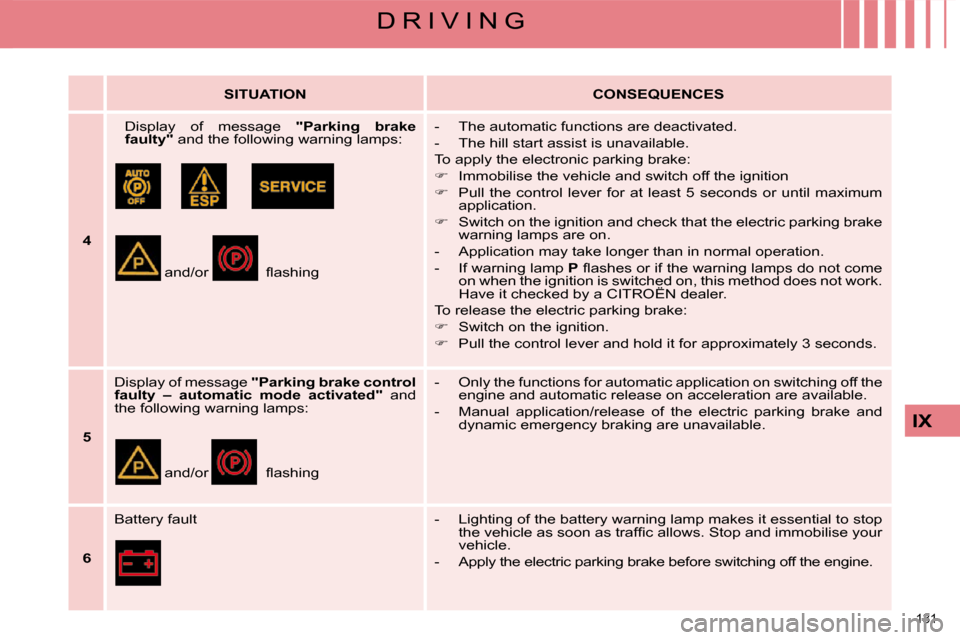
131
IX
D R I V I N G
SITUATION
CONSEQUENCES
4 Display of message
" Parking brake
faulty " � �a�n�d� �t�h�e� �f�o�l�l�o�w�i�n�g� �w�a�r�n�i�n�g� �l�a�m�p�s�:�
and/or
� �fl� �a�s�h�i�n�g� - The automatic functions are deactivated.
- The hill start assist is unavailable.
� �T�o� �a�p�p�l�y� �t�h�e� �e�l�e�c�t�r�o�n�i�c� �p�a�r�k�i�n�g� �b�r�a�k�e�:�
� Immobilise the vehicle and switch off the ignition
� Pull the control lever for at least 5 seconds or until maximum
application.
� Switch on the ignition and check that the electric parking brake
warning lamps are on.
- Application may take longer than in normal operation.
- If warning lamp P� � �fl� �a�s�h�e�s� �o�r� �i�f� �t�h�e� �w�a�r�n�i�n�g� �l�a�m�p�s� �d�o� �n�o�t� �c�o�m�e�
on when the ignition is switched on, this method does not work.
Have it checked by a CITROËN dealer.
� �T�o� �r�e�l�e�a�s�e� �t�h�e� �e�l�e�c�t�r�i�c� �p�a�r�k�i�n�g� �b�r�a�k�e�:�
� Switch on the ignition.
� Pull the control lever and hold it for approximately 3 second s.
5 Display of message
" Parking brake control
faulty – automatic mode activated " and
�t�h�e� �f�o�l�l�o�w�i�n�g� �w�a�r�n�i�n�g� �l�a�m�p�s�:�
and/or
� � �fl� �a�s�h�i�n�g� - Only the functions for automatic application on switchi
ng off the
engine and automatic release on acceleration are available.
- Manual application/release of the electric parking brake a nd
dynamic emergency braking are unavailable.
6 Battery fault - Lighting of the battery warning lamp ma
kes it essential to stop
�t�h�e� �v�e�h�i�c�l�e� �a�s� �s�o�o�n� �a�s� �t�r�a�f�fi� �c� �a�l�l�o�w�s�.� �S�t�o�p� �a�n�d� �i�m�m�o�b�i�l�i�s�e� �y�o�u�r�
vehicle.
- Apply the electric parking brake before switchi ng off the engine.
Page 167 of 337

133
IX
D R I V I N G
5-SPEED MANUAL GEARBOX
Starting the vehicle
� Check that the gear lever is in
neutral.
� Do not touch the accelerator.
� � � �F�o�r� �D�i�e�s�e�l� �e�n�g�i�n�e�s�:� �t�u�r�n� �t�h�e�
key to position M and wait until
the pre-heating warning lamp
switches off if it has come on.
� Operate the starter, turning the
key until the engine starts (no
more than ten seconds).
� In temperatures lower than 0 °C,
declutch whilst turning the starter
to facilitate starting.
6-SPEED ELECTRONIC GEARBOX SYSTEM
The 6-speed electronic gearbox of-
fers a choice between the comfort of
fully automatic operation or the driving
pleasure of manual gear changing.
Therefore, you have a choice of two
�d�r�i�v�i�n�g� �m�o�d�e�s�:�
- the automatic mode for auto-
matic control of the gears by the
gearbox,
- the sequential mode for manu-
al changing of the gears by the
driver.
� � � �a�u�t�o�m�a�t�i�c� �m�o�d�e�:� �s�e�l�e�c�t�o�r� � 2 in
position A .
� � � �m�a�n�u�a�l� �m�o�d�e�:� �s�e�l�e�c�t�o�r� � 2 in posi-
tion M .
In automatic mode, instant manual
operation is possible any time you
action one of the paddles "+" or "-".
Mode selection
Only engage reverse gear when
the vehicle is stationary with the
engine at idle.
Engaging reverse gear
� Push the gear lever to the right
then rearwards.